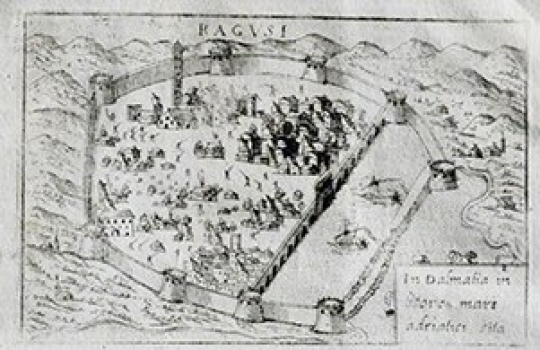À VAREA, LASOR: DUBROVNIK / RAGUSA
The View of Dubrovnik is located in the page of "Universus Terrarum Orbis scriptorum calamo delienatus", which Alphonse Lasor a Varea (Raffael Savonarola) published as a kind of compendia or lexicon of the geographic knowledge of that time. He included all the copper engravings of the 16th and 17th century Italian copper engravers that he could find, so that many of them would be accessible and saved from oblivion, even though some were heavily worn out due to extended use. The view of Dubrovnik is originally from the work of Francesco Valegio Raccolta di le piu illustri et famose citta di tutto il mondo which came out in Venice around 1600 in response to some earlier books of views of Venetian cartographers and publishers Forlani, Zenoi and Bertelli, and in particular Braun and Hogenberg's monumental work Civitates orbis terrarum. Valegio's atlas was very popular and several editions were preserved, most recently published by Venetian publisher Donato Rasicoti between 1610 and 1620, featuring views of more than 300 cities, including Dubrovnik, Zadar and Poreč. It is important to note that a great number of views were drawn and engraved by Martin Rota Kolunić, a cartographer and engraver from Šibenik. Dubrovnik is faithfully depicted from the semi-bird’s-eye view and before the earthquake, so that the existing high bell tower of the Franciscan monastery is particularly emphasized.

